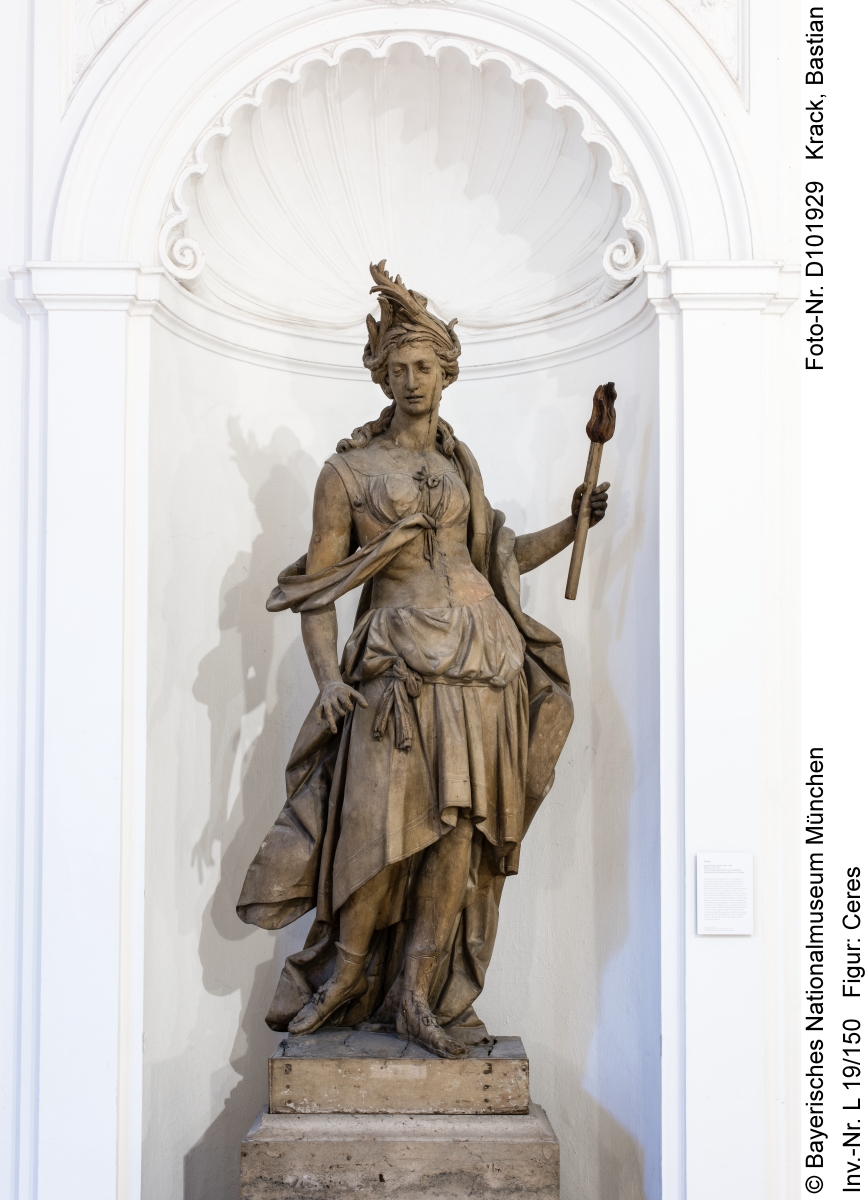Location
Germany, Bavaria, Munich
Bavarian National Museum Munich (Bayerisches Nationalmuseum München)
Artwork
Sculptures of Ceres and Imperator from the Former Törring Palace in Munich in the Bavarian National Museum in Munich
Type
Sculpture
Critical History
For the palace of the family Törring-Jettenbach near the residence of the Bavarian Court J. B. Straub created 9 sculptures of more than life-size. There existed although 8 putti which held probably attributes of the sculptures. The sculptures represented antique gods like e. g. Diana, Mars or Roman Emperors like Augustus (?). The sculptures of Ceres and Imperator nowadays are presented in 2 niches of the staircase in the museum. The situation for these two might have been similar in the Palace of the family Törring-Jettenbach.
Not all sculptures can be identified exactly because attributes are lost. 1 Together with the inventary numbers the sculpture have names: Ceres, inv. no. L 19/150, Diana, inv. no. L 46/95, Hebe inv. no. L 46/97.1-2, Imperator inv. no. L 19/151, Jupiter inv. no. L 46/96, Kybele inv. no. L 46/94, Mars, inv. no. L 46/91, Minerva inv. no. L 46/93,/1-2. Venus inv. no. L 46/92.1-2. In palace the sculptures were installed in the staircase and vestibule. The gilder Aloys Thurner received the rest of a payment for painting the sculptures (white with partial gildings) in 1774. Lippert mentioned in his list (1772) these works of art even though they were shown in the palace in 1773 one year later as the publication of his "Kurzgefaßte Nachrichten...."2
Three of the bozzetti Straub had modelled in terracotta for this sculptural cycle belong to the collections of the Bavarian National Museum in Munich.
The photos have the no. D101929 (Ceres) and D101930 (Imperator).
The link to the website of the museum is: www.bayerisches-nationalmuseum.de
Construction / Execution
The sculptures are made by wood. They had origianally a monochrome white painting layer without any partial gildings.
Components
- Sculpture
- Author: Johann Baptist Straub (Wiesensteig ca. 1704 – Munich 1784)
- Completed: 1772
- Technique(s): wood carving
- Polychromy
- Author: Aloys Thurner
- Completed: 1772
- Patron(s): Maximilian Emanuel von Törring-Jettenbach, noble
- Technique(s): oily tempera
- Material(s): Champagne chalk, dolomite, lead white, oil, organic black, protein
Comment
During her diploma thesis in 2006 (TU-München RKK) Sophie Eichner examined the 9 sculptures that are now in the Bavarian National Museum. The results are collected in her printed diploma thesis "Ein Skulpturenzyklus von Johann Baptist Straub. Neun antike Gottheiten aus dem Treppenhaus des ehem. Palais Toerring in München."
The monochrome painting layer imitated white stone. The surface was not polished. There was no partial gilding as Volk presumed. Two overpaintings might have been executed in 1835 in context with architectonic changes for the function of the palace as the Main Postoffice. In 1898 there was a renovation of this building this might be the reason for a second overpainting. 3
Images
- The sculpture of Ceres of the former Törring Palace in Munich in the Bavarian National Museum in Munich
- The sculpture of Imperator of the former Törring Palace in Munich in the Bavarian National Museum in Munich
Catalogue entry prepared by Rupert Karbacher
Recommended citation: Rupert Karbacher, Sculptures of Ceres and Imperator from the Former Törring Palace in Munich in the Bavarian National Museum in Munich, in: TrArS – Tracing the Art of the Straub Family, 2018, (accessed 18/11/2025) URL


